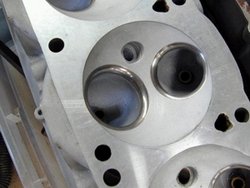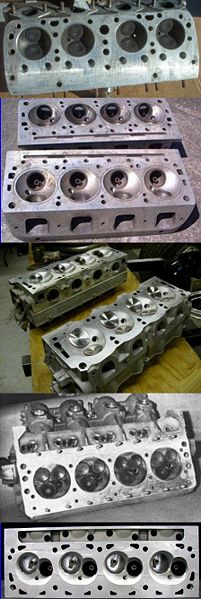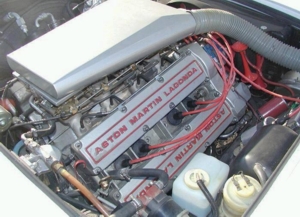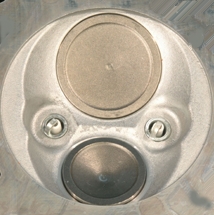Hemi engine
A Hemi engine (from hemisphere) is an internal-combustion engine in which the combustion chambers are of hemispherical form. The term "Hemi engine" is a trademark of Chrysler Corporation, though they were neither the hemi engine's inventors nor the first to commercialize hemi engines.
Hemispherical combustion chambers, which had been used for centuries in mortars and cannon, were introduced on some of the very earliest automotive engines, shortly after proving the concept of internal combustion engines themselves.
Technology & implementation

With the hemispherical combustion chamber design, the intake and exhaust valves are usually on opposite sides of the chamber, unlike the in-line valve arrangement common to most engines with wedge-shaped combustion chambers. Therefore, significant challenges in the commercialization of hemi engines revolved around the design of the valve actuation, and how to make it effective, efficient, and reliable at an acceptable cost. Early in Chrysler's development of their 1950s hemi engine, the head was referred to internallyTemplate:Who? as the "double rocker" head, not as the hemi head.
Benefits & drawbacks
Although a wedge-head design offers simplified valve actuation, it usually requires the air/fuel mixture to make sharp turns en route to and from the chamber. With a hemispherical chamber, larger valves are possible and a straighter, less restrictive flow path can be provided for the air/fuel mixture. This improves engine breathing. Placing the spark plug near the center of the chamber aids in achieving complete combustion of the fuel/air mixture, though it is not mandatory.
Drawbacks of the hemispherical chamber such as increased production cost, high relative weight (25% heavier than a comparable wedge head per Chrysler's engineers, poor low-rpm performance characteristics and difficulty meeting emissions standards have pushed the hemi head out of favor.
History & usage
Hemispherical cylinder heads have been used since at least 1903; they were used by the Belgian car maker Pipe in 1905, the Peugeot Grand prix Car of 1912, the Alfa Romeo GP car of 1914, Daimler, and Riley. Stutz built four valve engines, conceptually anticipating modern car engines. The BMW double push rod design, taken over by Bristol Cars, the Peugeot 403 and the Toyota T engine are other well known hemi engines. Harry Arminius Miller racing engines were also a notable example.
Chrysler
Perhaps the most widely known proponent of the hemispherical chamber design is the Chrysler Corporation. Chrysler became identified primarily by trademarking the "Hemi" name and then using it extensively in their advertising campaigns beginning in the 1960's. Chrysler has produced three generations of such engines: the first (the Chrysler FirePower engine) in the 1950s, the second (the 426 Hemi), developed for NASCAR in 1964 and produced through the early 1970s, and finally the "new Hemi" in the early 2000's. The "Hemi" engine introduced in 2002 by DaimlerChrysler had a combustion chamber featuring valve and spark plug locations markedly different from the 426ci Hemi engine of muscle car fame. The current-production "Hemi" V8 with its pinched chamber, does not have true hemispherical combustion chambers despite the name. Rather, it bears a closer resemblance to the mid-1950's Polyspherical chamber, which Chrysler engineers developed as a lower cost alternative head for their V8 engines. The Polyspherical head needed less metal and was narrower due to using only one rocker shaft. This saved costs in material, space and warranty claims and allowed it to be used in smaller vehicles. Chrysler's Australian-market Hemi-6 of 1970-80 had partial-spherical hemi chambers, though they were only 35% of a sphere.
Ford
Ardun heads for the Ford Flathead were perhaps the first use of a hemispherical head on a readily available American V8. First offered in 1947 as an aftermarket product, these heads converted the Ford Flathead to overhead valves operating in a hemispherical chamber. Zora Arkus-Duntov, who later worked for GM and was a major force behind the development of the Chevrolet Corvette, and his brother Yura, were the "AR" "DUN" of "Ardun".
Ford produced an engine with two overhead cams (one cam per head) and hemispherical chambers in the mid-1960's. The engine, displacing 425 in³ and belonging to the FE family of Ford engines, was known as the "427 SOHC". Also know as the "Cammer". It was basically a set of SOHC hemi heads that bolted onto Ford's FE engine block. The 1964 engine was designed in 90 days of intensive engineering effort for use in racing. The 427 SOHC used the side oiler engine block modified slightly to deal with the missing in-block cam among other OHC issues. Because of its power levels it was banned from NASCAR races, though allowed in certain drag racing classes. After the NASCAR ban, Ford continued to produce the 427 SOHC for several years and sold it over the counter to racers and others. Dynamometer results of the day showed the SOHC Hemi producing almost 700 HP in crate form (100 hp per liter), before any modifications by the purchaser.
Later Ford engine designs with hemispherical chambers included the Calliope, which used two in-block cams, arranged one over the other, to drive 3 valves per hemispherical chamber. The pushrods activating the valves from the top camshaft were almost horizontal. In 1968, Ford brought out a completely new engine family called the "385-series". This engine's heads used a modified form of the hemispherical chamber that was referred to as a "Semi-Hemi". In the 1970's, Ford designed and produced a smallblock engine with hemispherical heads to address the growing concerns about fuel economy. Unfortuately, even with an ahead-of-its-time GDI system feeding a stratifed charge chamber, the hemi's emissions could not be made clean enough for compliance with regulations. This plus the cost of the valve actuation systems, along with the cost of the high pressure pump needed to deliver fuel directly into the chamber, as well as the gilmer belt drive system needed to drive the pump, made further development pointless.
Aston Martin
Aston Martin's famous DOHC (4 cams) V8 used hemispherical chambers as well during the late 1960's through the late 1980's, until Ford purchased Aston Martin and funded the development of new engines, with modern combustion chambers. The new engines increased the horsepower using less displacement: Aston Martin V8 5.3 L (5340 cc/325 in³) with 315 hp (235 kW) replaced by the Ford V8 Vantage 4.3 L (4300 cc) quad-cam 32-valve V8 with 380 hp (283 kW).
Porsche
Porsche has made extensive use of hemi-head engines, including the air-cooled flat-6 engine in Porsche 911 models from 1963 to 1999. The 1973 2.4 L version generated 56 hp per naturally-aspirated litre ofpiston displacement.
Jaguar
Jaguar used this head design, beginning in 1949, on the legendary XK engines, which powered cars ranging from the Le Mans winning D-Type to the XJ6 sedan.
Mitsubishi
Mitsubishi produced several hemi engines including the 'Orion', 'Astron', and 'Saturn' units.
Supersession in modern engines
Many of today's engines use active combustion chambers designed to tumble and swirl the fuel/air mix within the chamber for the most efficient combustion event possible. These active chambers usually look like kidney beans or two merged small 'hemi' areas surrounded by flat quenching areas over the pistons. By the end of the 1970's, development of engines utilizing true hemispherical chambers had ceased around the world; it has been supplanted and dramatically improved upon by newer designs. Today, "hemi" is little more than a copyrighted word that bears little meaning, descriptively, for the engines designated as such.
| Piston engine configurations | |
|---|---|
| Straight | Single, 2, 3, 4, 5, 6, 8, 9, 10, 12, 14 |
| V | 2, 4, 5, 6, 8, 10, 12, 16, 20, 24 |
| Flat | 2, 4, 6, 8, 10, 12, 16, H |
| W | 8, 9, 12, 16, 18 |
| Other inline | H, VR, Opposed, U (Square), X |
| Other | Hemi, Radial, Rotary, Pistonless, Deltic, (Wankel) |
| Heat engines | |
|---|---|
| Stroke cycles One • Two • Four • Six • | |
| Engine types Gas turbine • Piston • Jet • Rocket engine • Steam engine • Stirling engine • Tschudi• Twingle Rotary • Wankel • Free-piston • Britalus • Coomber • Swing-piston • Orbital • Quasiturbine | |
| Valves Cylinder head porting • D slide • Four-stroke • Manifold • Multi • Piston • Poppet • Sleeve | |
| Piston layouts Single cylinder • Straight • Opposed • Flat • V • W • H • Deltic • Radial • Rocket engine nozzle • Rotary • Stelzer • Controlled Combustion • Bourke | |
| Motion mechanisms Cam • Connecting rod • Coomber rotary • Crank • Crank substitute • Crankshaft • Linkages (Evans • Peaucellier-Lipkin • Sector straight-line • Watt) • Double acting/differential cylinder | |
| Thermodynamic cycle |




